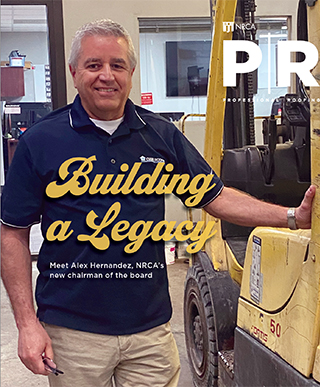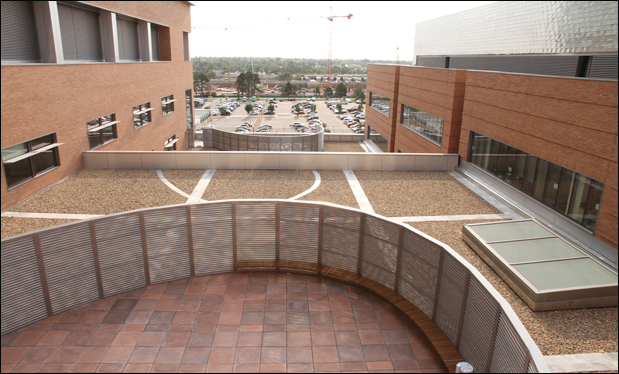NRCA has released a new publication, NRCA Guidelines for Complying With Building Codes Using ANSI/SPRI ES-1, which will help designers properly design and specify perimeter edge-metal flashings to comply with building code requirements and ANSI/SPRI ES-1, "Wind Design Standard for Edge Systems Used with Low Slope Roofing Systems." The new guidelines include important information designers of low-slope membrane roof systems should know.
NRCA's guidelines
NRCA's ES-1 guide is composed of eight chapters and four appendices.
Chapter 1 provides an overview of the document's content and an introduction to wind forces acting on buildings' roofs.
Chapter 2 features background information regarding ANSI/SPRI ES-1, the International Building Code®'s (IBC®'s) adoption of ANSI/SPRI ES-1 and ASCE 7, "Minimum Design Loads for Buildings and Other Structures," which is referenced in the IBC and used with ANSI/SPRI ES-1. IBC 2006, 2009 and 2012 references ANSI/SPRI ES-1-03 (2003 edition); IBC 2015 references ANSI/SPRI/FM 4435/ES-1-11 (2011 edition).
Chapter 3 provides an overview of ANSI/SPRI ES-1-03. ANSI/SPRI ES-1-03 does not require nor suggest the use of a safety factor when comparing tested resistance values with design wind loads; however, NRCA suggests designers consider using a minimum safety factor in their calculations. Also, ANSI/SPRI ES-1-03 requires doubling fasteners in corner regions to address higher wind loads. Because flexural failure during edge metal testing is much more common than fastener pull-out, this simple multiplication factor may result in inadequately addressing wind loads in corner regions.
Chapter 4 provides an overview of ANSI/SPRI/FM 4435/ES-1-11. ANSI/SPRI/FM 4435/ES-1-11 includes a minimum safety factor of 2.0 in its wind-load calculations and more properly addresses perimeter and corner regions in design wind-load calculations than ANSI/SPRI ES-1-03. However, the pressure coefficients included in ANSI/SPRI/FM 4435/ES-1-11 differ from those in ASCE 7-05, making code-compliant wind-load determination using ANSI/SPRI/FM 4435/ES-1-11 a concern.
Chapter 5 provides an overview of wind-load calculations for roof area perimeter and corner regions using ASCE 7-05 and ASCE 7-10. NRCA recommends designers use the edition of ASCE 7 that applies to the specific edition of IBC adopted by a jurisdiction. IBC 2006 and 2009 reference ASCE 7-05, while IBC 2012 and IBC 2015 reference ASCE 7-10. Also, IBC Chapter 16-Structural Design requires designers to include design wind loads in contract documents. NRCA recommends designers clearly note design wind loads for roof area perimeters and corners in their drawings or specifications.
Chapter 6 gives an overview of design wind-resistance capacity. The fundamental concept of wind design is the tested design wind resistance (uplift resistance) should be equal to or greater than the design wind loads determined using the appropriate edition of ASCE 7.
Chapter 7 discusses ANSI/SPRI ES-1-03's and ANSI/SPRI/FM 4435/ES-1-11's test methods for determining an edge-metal flashing's design wind resistance. Separate test methods are provided for gravel stop and fascia profiles and copings. Edge metal manufacturers and suppliers typically can provide test data for their profiles. NRCA also has conducted testing on a number of common edge-metal profiles.
Chapter 8 offers several example calculations illustrating the use of ASCE 7 and ANSI/SPRI ES-1 for proper code-compliant wind design.
The appendices provide information comparing ANSI/SPRI ES-1-03 and ANSI/SPRI/FM 4435/ES-1-11, NRCA's ANSI/SPRI ES-1 certification programs, design considerations for wood blocking at roof edges and applicable definitions.
Closing thoughts
Properly designing and specifying code-compliant edge-metal flashings is a relatively complex task and complicated by having to know which specific editions of the building code, ANSI/SPRI ES-1 and ASCE 7 are applicable.
NRCA developed NRCA Guidelines for Complying With Building Codes Using ANSI/SPRI ES-1 to help roof system designers properly design and specify code-compliant edge-metal flashings.
Mark S. Graham is NRCA's associate executive director of technical services.



